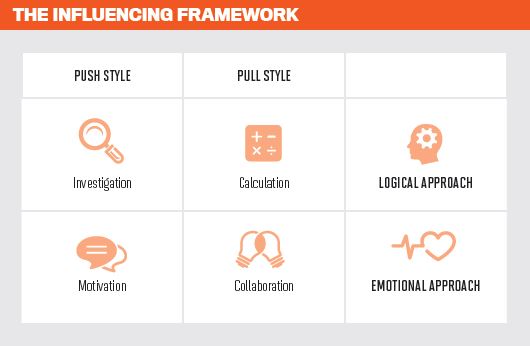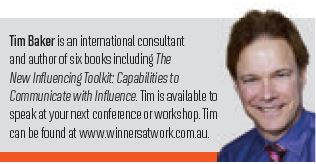Influencing a client doesn’t have to involve manipulation and deceit. Tim Baker explains how brokers can influence clients in an ethical manner.
The word ‘influence’ means many things to many people. To some it means being cunning, manipulative and tricky, while others consider influence the lifeblood of communication. We are all in the business of influence. Financial professions are arguably professional influencers. Getting better at influencing should be an important and ongoing goal for all brokers.
Influence, according to the Oxford Dictionary, is the capacity to have an effect on the character, development or behaviour of someone or something. It ought to be done ethically. To me, influencing can be defined as ‘The power to make other people agree with your opinions or get them to do what you want willingly and ethically’
There are three variables involved in any influencing situation or circumstance. One variable is your personal style and approach. You will tend to influence others the way you like to be influenced. Secondly, the person you are influencing also has a preference for how they like to be influenced. Use the ‘wrong strategy’ and it won’t work. We’ve all experienced this! And finally, each situation will favour a certain type of strategy. These three variables help explain why the influencing attempt has been successful or unsuccessful.
In the context of broking, influence is about persuading others to think and act differently in ways that benefit them and their families. It certainly does not mean manipulation or trickery. Influencing, in my opinion, must be done from an ethical standpoint.
My new model of influencing identifies four primary ways brokers (or anyone) can and do influence others. I refer to this model as the ‘Influencing Capabilities Framework’. The chart below gives a glimpse of the framework.
Let’s briefly consider each of these influencing strategies.
 Investigation
Investigation
As a strategy of influence, investigation basically means gathering the facts and presenting them in a logical and convincing manner. The presentation of a coherent and assertive argument based on well-founded research is a powerful form of persuasion in the right set of circumstances.
On the contrary, people are usually not convinced by someone who does not have a sound grasp of the facts; nor are they influenced by someone with wavering conviction or an incoherent presentation of their ideas. Then again, even if you are logical, coherent, assertive and well researched, that doesn’t necessarily guarantee that you will be persuasive. But these attributes are at least a good starting point.
Financial professionals who have a preference for investigating like to search for supporting evidence and from this data generate hypotheses or ideas based on logical, rational arguments. Once investigators have prepared a well-founded case, they assert their theories or ideas to infl uence others. Being well prepared, investigators are typically on solid ground to oppose others’ arguments. Briefly, an investigator’s infl uencing ability is reliant on a carefully researched and assertively communicated case.
Climate change campaigner and former US vice president Al Gore is an investigator.
Calculation
The calculation strategy means to infl uence by clearly articulating the pitfalls of the status quo on the one hand and how those pitfalls can be overcome with a new proposal on the other. Psychologists tell us that we are all motivated by pain and pleasure. In other words, we try to avoid painful situations as much as we can, such as being late for an important meeting we are chairing. Conversely, we gravitate to pleasurable experiences, such as pleasing our client by fi nding the right information in a timely manner. While this should appear obvious to us, we each have different ideas of what pain and pleasure are. What this means is that we interpret the signifi cance of situations in our own way. A potentially painful situation for one person could be viewed as enjoyable by another.
Former UK prime minister Margaret Thatcher was a calculator.
Motivation
The motivation strategy in essence means to be influential by associating the idea, change or proposal with a clear, compelling and common vision of the future. Leaders who can paint a convincing picture of the future and motivate people with that vision are generally inspirational and motivating. Most great leaders have this aptitude.
Unfortunately, from my observations too many people in sales professions get caught up in the minutiae of what they are doing. They consequently often forget to articulate the link between the product, service or concept and the overall financial strategy of the client.
Furthermore, professionals – whether they are fi nancial or otherwise – don’t always explain the why. The why refers to why we are suggesting this course of action. How does what we are currently doing contribute to the big picture? These are the questions motivators answer.
Former civil rights activist Martin Luther- King was a motivator.
Collaboration
The strategy of collaboration fundamentally involves infl uencing through trust-building and sharing the ownership of the planner’s proposal. Clients are more likely to be persuaded by a professional’s suggestion if they feel they have been genuinely consulted about it. Clients feel they have an emotional stake in the planning and are subsequently more receptive to its merits. Through authentic collaboration, trust builds and influence increases.
Collaborators create positive emotional energy. They are concerned with developing a sense of trust and engagement with the people they work with. Collaborators are consultative in their approach to problem solving; they actively listen to others and are willing to share the ownership of the outcomes through open communication. The influence of collaborators permeates from encouraging input and building higher than normal levels of confidence in clients.
The late activist for the needy and poor in India and everywhere around the world, Mother Teresa, was a collaborator.
Each of us has an influencing profi le; that is, we favour one of these four strategies over the other three. The problem with that is we will from time to time doubtlessly use the wrong strategy, either for the person we are trying to persuade or the situation we are in. Outstanding influencers use all four strategies in the right place and at the right time.
Which strategy do you tend to favour?

Influence, according to the Oxford Dictionary, is the capacity to have an effect on the character, development or behaviour of someone or something. It ought to be done ethically. To me, influencing can be defined as ‘The power to make other people agree with your opinions or get them to do what you want willingly and ethically’
There are three variables involved in any influencing situation or circumstance. One variable is your personal style and approach. You will tend to influence others the way you like to be influenced. Secondly, the person you are influencing also has a preference for how they like to be influenced. Use the ‘wrong strategy’ and it won’t work. We’ve all experienced this! And finally, each situation will favour a certain type of strategy. These three variables help explain why the influencing attempt has been successful or unsuccessful.
In the context of broking, influence is about persuading others to think and act differently in ways that benefit them and their families. It certainly does not mean manipulation or trickery. Influencing, in my opinion, must be done from an ethical standpoint.
My new model of influencing identifies four primary ways brokers (or anyone) can and do influence others. I refer to this model as the ‘Influencing Capabilities Framework’. The chart below gives a glimpse of the framework.
Let’s briefly consider each of these influencing strategies.
 Investigation
InvestigationAs a strategy of influence, investigation basically means gathering the facts and presenting them in a logical and convincing manner. The presentation of a coherent and assertive argument based on well-founded research is a powerful form of persuasion in the right set of circumstances.
On the contrary, people are usually not convinced by someone who does not have a sound grasp of the facts; nor are they influenced by someone with wavering conviction or an incoherent presentation of their ideas. Then again, even if you are logical, coherent, assertive and well researched, that doesn’t necessarily guarantee that you will be persuasive. But these attributes are at least a good starting point.
Financial professionals who have a preference for investigating like to search for supporting evidence and from this data generate hypotheses or ideas based on logical, rational arguments. Once investigators have prepared a well-founded case, they assert their theories or ideas to infl uence others. Being well prepared, investigators are typically on solid ground to oppose others’ arguments. Briefly, an investigator’s infl uencing ability is reliant on a carefully researched and assertively communicated case.
Climate change campaigner and former US vice president Al Gore is an investigator.
Calculation
The calculation strategy means to infl uence by clearly articulating the pitfalls of the status quo on the one hand and how those pitfalls can be overcome with a new proposal on the other. Psychologists tell us that we are all motivated by pain and pleasure. In other words, we try to avoid painful situations as much as we can, such as being late for an important meeting we are chairing. Conversely, we gravitate to pleasurable experiences, such as pleasing our client by fi nding the right information in a timely manner. While this should appear obvious to us, we each have different ideas of what pain and pleasure are. What this means is that we interpret the signifi cance of situations in our own way. A potentially painful situation for one person could be viewed as enjoyable by another.
Former UK prime minister Margaret Thatcher was a calculator.
Motivation
The motivation strategy in essence means to be influential by associating the idea, change or proposal with a clear, compelling and common vision of the future. Leaders who can paint a convincing picture of the future and motivate people with that vision are generally inspirational and motivating. Most great leaders have this aptitude.
Unfortunately, from my observations too many people in sales professions get caught up in the minutiae of what they are doing. They consequently often forget to articulate the link between the product, service or concept and the overall financial strategy of the client.
Furthermore, professionals – whether they are fi nancial or otherwise – don’t always explain the why. The why refers to why we are suggesting this course of action. How does what we are currently doing contribute to the big picture? These are the questions motivators answer.
Former civil rights activist Martin Luther- King was a motivator.
Collaboration
The strategy of collaboration fundamentally involves infl uencing through trust-building and sharing the ownership of the planner’s proposal. Clients are more likely to be persuaded by a professional’s suggestion if they feel they have been genuinely consulted about it. Clients feel they have an emotional stake in the planning and are subsequently more receptive to its merits. Through authentic collaboration, trust builds and influence increases.
Collaborators create positive emotional energy. They are concerned with developing a sense of trust and engagement with the people they work with. Collaborators are consultative in their approach to problem solving; they actively listen to others and are willing to share the ownership of the outcomes through open communication. The influence of collaborators permeates from encouraging input and building higher than normal levels of confidence in clients.
The late activist for the needy and poor in India and everywhere around the world, Mother Teresa, was a collaborator.
Each of us has an influencing profi le; that is, we favour one of these four strategies over the other three. The problem with that is we will from time to time doubtlessly use the wrong strategy, either for the person we are trying to persuade or the situation we are in. Outstanding influencers use all four strategies in the right place and at the right time.
Which strategy do you tend to favour?




